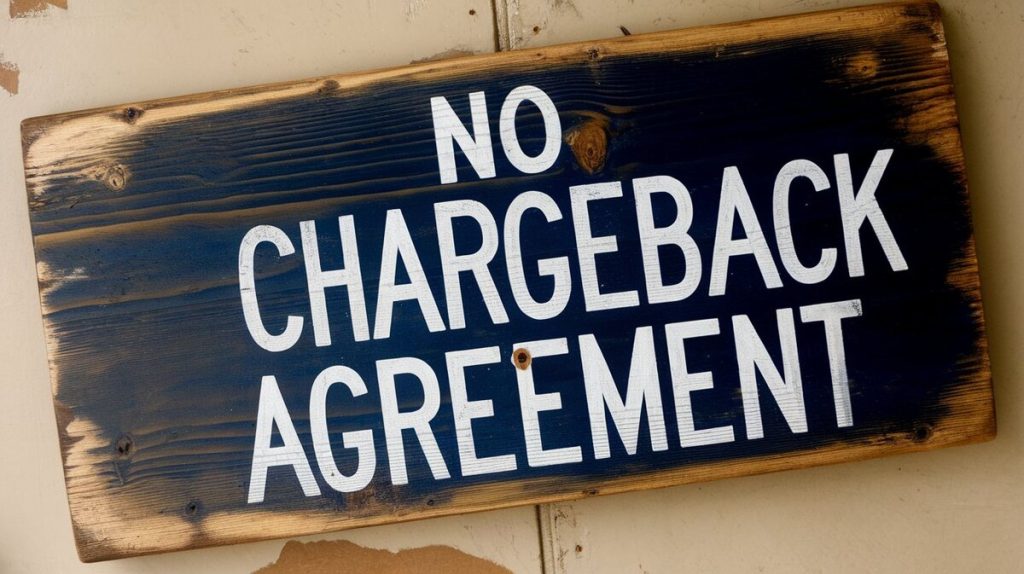Introduction
Chargebacks are a persistent issue for businesses in the e-commerce and digital payments sectors. In 2023, global chargeback costs were estimated at $40 billion annually, impacting companies of all sizes. Chargebacks were originally designed to protect consumers from fraudulent transactions, but they can also create significant challenges for merchants due to “friendly fraud” and customer disputes.
A “No Chargeback Agreement” is one approach some businesses consider to mitigate chargebacks. However, the enforceability and effectiveness of such agreements are complex and often misunderstood.
What is a No Chargeback Agreement?
A No Chargeback Agreement is a clause that merchants include in their terms of service or sales contracts. It requires customers to resolve any disputes directly with the merchant instead of initiating a chargeback through their bank. The goal is to prevent the often costly and time-consuming chargeback process.
Despite the appeal, banks and payment networks like VISA and MasterCard do not recognize these agreements as legally binding. Under U.S. law, for instance, consumers retain the right to request a chargeback in certain situations, regardless of any agreement they may have signed.
Table 1: Common Reasons for Chargebacks
| Reason | Percentage of Total Chargebacks |
|---|---|
| Fraudulent transactions | 58% |
| Unrecognized transactions | 20% |
| Product/service not as described | 12% |
| Product not received | 7% |
| Duplicate transactions | 3% |

Legality and Enforceability
No Chargeback Agreements are generally not enforceable. According to the Fair Credit Billing Act (FCBA) in the U.S., consumers cannot waive their right to dispute charges with their bank. This law protects consumers from unauthorized or fraudulent transactions.
For example, if a customer signs a No Chargeback Agreement but later disputes the transaction with their bank, the bank will likely side with the customer if there’s a valid reason for the chargeback. VISA and MasterCard guidelines also state that merchants cannot require customers to waive their chargeback rights.
Challenges and Risks
No Chargeback Agreements present significant risks:
- Customer Trust: These agreements can damage customer relationships, as consumers may perceive them as a denial of their rights.
- Bank Compliance: Banks and card networks usually disregard these agreements. If a customer files a chargeback, the bank processes it regardless of the No Chargeback Agreement.
- Legal Consequences: Attempting to enforce these agreements might lead to legal disputes, further increasing costs.
Alternatives to No Chargeback Agreements
Given the challenges, merchants should consider effective alternatives to minimize chargebacks.
- Clear Communication and Policies:
- Product Descriptions: Ensure all product descriptions are accurate and detailed. Misleading descriptions often cause chargebacks.
- Return and Refund Policies: Clearly state return and refund policies. Ensure they are easily accessible and understandable.
- Enhance Customer Service:
- 24/7 Support: Round-the-clock customer support can prevent disputes from escalating to chargebacks.
- Proactive Communication: Send automated updates during the transaction process to keep customers informed.
- Fraud Prevention Tools:
- AVS and CVV Verification: Use Address Verification Service (AVS) and Card Verification Value (CVV) codes to prevent fraudulent transactions.
- 3D Secure Authentication: Implement 3D Secure (3DS) to add an extra layer of security, reducing fraud-related chargebacks.
Table 2: Effective Chargeback Prevention Strategies
| Strategy | Potential Chargeback Reduction |
|---|---|
| Detailed Product Descriptions | 30% |
| Clear Refund Policies | 25% |
| 24/7 Customer Support | 20% |
| Fraud Detection Tools | 15% |
| Proactive Communication | 10% |

Best Practices for Chargeback Prevention
Implementing industry best practices can significantly reduce the risk of chargebacks. These practices are recommended by leading payment processors such as Stripe and Checkout.com.
- Refine Your Terms of Service (ToS):
- Ensure your ToS is comprehensive and transparent. Include details about the purchase process, delivery expectations, and acceptable use of your product or service.
- Invest in Anti-Fraud Tools:
- Use machine learning-based fraud detection systems that analyze transaction patterns and flag suspicious activity.
- Leverage Chargeback Alerts:
- Sign up for chargeback alerts provided by card networks. These alerts notify you when a chargeback is initiated, allowing you to resolve the issue before it escalates.
Partnerships in Chargeback Prevention
To manage and prevent chargebacks effectively, partnering with a specialized service provider can be beneficial. Merchanto.org, an official partner of VISA and MasterCard, offers comprehensive chargeback prevention solutions to help reduce disputes and protect your business. Learn more about their services here.
Conclusion
No Chargeback Agreements may seem like an easy solution, but they come with significant legal and practical risks. Instead of relying on these agreements, businesses should focus on improving customer service, enhancing communication, and investing in fraud prevention tools.
By adopting these strategies, merchants can reduce chargebacks and build stronger customer relationships, leading to increased customer loyalty and better business outcomes.
Table 3: Comparison of Chargeback Prevention Partners
| Provider | Specialization | Success Rate | Cost | Integration Time |
|---|---|---|---|---|
| Merchanto.org | Chargeback Prevention & Management | 95% | Medium | 2-4 weeks |
| Stripe | Payment Processing & Fraud Detection | 92% | High | 1-2 weeks |
| Checkout.com | Global Payment Processing | 90% | High | 1-3 weeks |
| Braintree | Payment Gateway & Fraud Tools | 88% | Medium | 2-3 weeks |
In conclusion, merchants must stay informed and proactive about chargeback prevention. By focusing on customer satisfaction and leveraging technology, you can safeguard your business against the costly effects of chargebacks.



